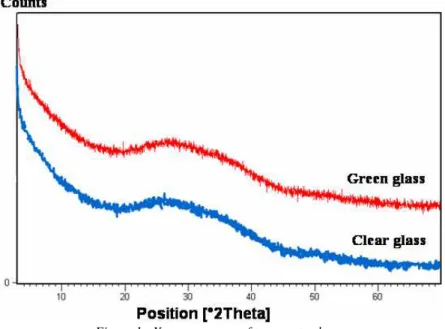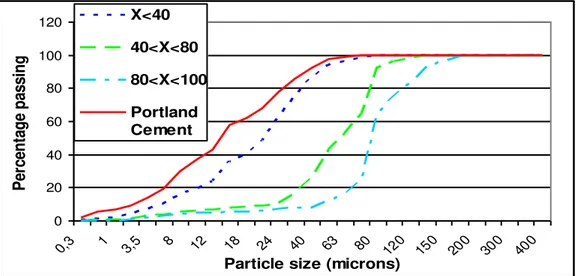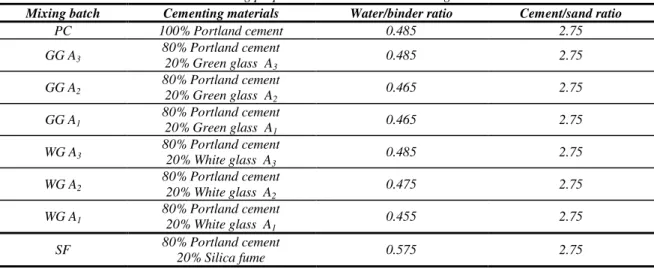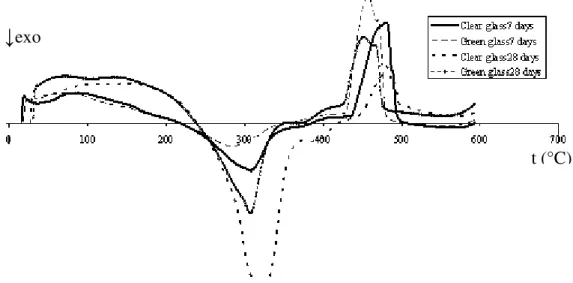322
ASSESSEMENT OF THE WASTE GLASS POWDER POZZOLANIC
ACTIVITY BY DIFFERENT METHODS
A. Khmiri*, B. Samet & M. Chaabouni
Laboratoire de Chimie Industrielle, Ecole Nationale d'Ingénieurs de Sfax, BP W 3038, Sfax, Tunisie *E-mail address : Khmiri.abdelhafidh@yahoo.fr; Tel. +216 52288806
ABSTRACT
The purpose of this work is the study of the use of waste glass obtained from crushed containers and building demolition as partial Portland cement replacement in mortar and concrete. For this, the waste glass must have the characteristics of pozzolanic material. In this context, a study of the pozzolanic activity of two types of glass clear and green coloured, with varying the particle size of the ground waste glass in the ranges: 100 and 80 μm, 80 and 40 μm and lower than 40 μm, was made. The glass cullet was first characterized by XRF and XRD. Then, the pozzolanic activity was assessed by chemical (Chapelle test), mechanical (compressive strength on mortar bars containing 20% of ground glass and 80% of cement at 28 days) and physical (dosage of Ca(OH)2 by DSC) methods. By chemical and physical methods, it was proved that calcium hydroxide causes the hydrolysis of the waste class, followed by calcium silicate hydrate formation. By mechanical method, it was concluded that the use of waste glass as partial replacement of Portland cement requires the grinding of the waste glass to a particle size lower than 40 μm without regard to samples colour.
Key words
:
pozzolanic activity, waste glass, pozzolan, cementitious material.1. INTRODUCTION
The waste glass constitutes a problem for solid waste disposal in several municipalities. The current practice is still to landfill most of the nonrecyclable glass. Since glass is a nonbiodegradable material, these landfills do not constitute an environmental solution. For this reason, there is a strong need to valorise this waste glass.
The use of the waste glass in the construction industry is among the most attractive option because it can consume a significant quantity of these materials; it does not ask for very high conditions of quality and are used in several widespread building sites of construction [1].
An attempt was put for a long time to test the use of the waste glass like aggregate in the concrete [2-5]. Due to the strong reaction between the alkali in cement and the reactive silica in glass, the use of glass in concrete as part of the coarse aggregate was not satisfactory because of the marked strength regression and excessive expansion. Recently some experiments were made to use this waste like a siliceous raw material for the production of Portland cement [6-7]. It was proved that the introduction of waste glass in cement production increased the alkali content in cement which could result in flash setting due to the high alkali content and the formation of 2CaSO4.K2SO4 [7].However, value addition of glass in concrete is best achieved if it is used as cement replacement material.
Glass is amorphous and high silica content, which is the primary requirement for a pozzolanic material. A particle size of 75m or less is reported to be favourable for pozzolanic activity [8]. The high alkali content of glass is a typical concern for its use in concrete, but studies [9-10] have shown that finely ground glass does not contribute to alkali-silica reaction.
Few studies have investigated the potential of finely ground waste glass powder as pozzolanic material [11-13]. It was demonstrated that the properties which influence the pozzolanic behaviour of waste glass, and most pozzolans in general, are fineness, composition and pore solution present for reaction. The pozzolanic properties of glass are first notable at particle sizes below approximately 300m. Below 100m, glass can have pozzolanic reactivity which is greater than that of fly ash at low percent cement replacement levels and after 90 days curing [11, 14]. Based on observed compressive strengths, Meyer et al. [15] postulated that below 45m, glass may become pozzolanic.
323 2. MATERIALS AND METHODS
2.1. Materials
2.1.1. Portland cement
A typical commercial type I 42,5 N Portland cement that complies with the requirements of specification ASTM C 150-04 is used as a testing cement. Its chemical composition is shown in table 1.
2.1.2. Silica fume
A commercial silica fume, conform to the requirement of the specification of ASTM C 1240-03a, is used as a reference pozzolan. The chemical composition of silica fume, as supplied by the manufacturer, is summarized in table 1.
2.1.3. Waste glass
The waste glass used in this study is a typical soda-lime glass obtained from recycled containers. Green and clear glasses which are the main colours of Tunisia market products are used in order to evaluate the influence of two types of glass on the pozzolanic activity. Chemical composition of green and clear glass cullet are also illustrated in table 1. The glass powder is obtained by crushing and grinding the glass in a jar mill in the laboratory, and by sieving the ground glass to the desired particle size. To study particle size effect, three different classes are used:
A1: ground glass having particle size in the range 100 - 80 μm;
A2: ground glass having particle size in the range 80 - 40 μm;
A3: ground glass having particle size lower than 40 μm.
2.2. Methods
The X-ray fluorescence analysis is conducted on a ARL 8400 apparatus to determine the chemical composition of cement, glass and silica fume. The particle size distribution of these raw materials is measured by using a laser particle size analyser (CILAS 920) and their specific surface by Blaine method.
The crystallinity of the glass is examined using X-ray diffraction technique. The X-ray diffraction (XRD) analysis is carried out using a Philips X'Pert Pro System. The generator settings are 45 kV and 40 mA and the wavelength (λ) is 1.5418 Å (Cu Kα). A scanning rate of 1° 2θ/min from 3° to 70° is considered.
The pozzolanic activity is assessed by three methods:
- Chemical method according to Chapelle test [16,17]: one gram of glass powder is mixed with 1g of CaO and 200 ml of water. The suspension is boiled for 16 h and the free Ca(OH)2 is determined by means of sucrose extraction and titration with a HCl solution.
- Mechanical method (pozzolanic reactivity index): the pozzolanic activity of both glasses with different finenesses is evaluated according to ASTM C311 test method [18]. In the test mixtures, 20% of the mass of the cement is replaced by glass powder or silica fume. The mix proportions and water requirements for these mortar mixes are summarized in table 2. The water-to-cement ratio for pure Portland cement (reference) is 0.485 as specified in ASTM C311. The water-to-cement ratio for other mixtures containing silica fume and ground glass are tested to reach the same flow than that of the reference.
324 3. RESULTS AND DISCUSSION
3.1. Material characterization
The chemical compositions of the raw materials determined by X-ray fluorescence are reported in Table 1.
Table 1: Chemical composition of raw materials
% Green glass Clear glass Silica fume Cem I 42.5 N
SiO2 71.44 71.48 93.17 20.59
Al2O3 1.70 1.60 0.32 6.62
Fe2O3 0.37 0.07 1.02 3.54
CaO 10.81 11.45 0.58 63.61
MgO 1.65 1.23 0.48 1.39
Na2O 13.24 13.36 0.3 0.13
K2O 0.36 0.48 1.17 0.61
SO3 0.16 0.27 0.12 1.94
TiO2 0.04 0.03 - -
Cr2O3 0.19 0.01 - -
First we notice that the principle differences between green and clear glass exist in the Fe2O3 and Cr2O3 contents. These oxides, which are higher in the green glass than in the clear one, are responsible of the characteristic colour of the green glass.
Compared to silica fume, the waste glass has higher CaO, Na2O and Al2O3, but much lower SiO2 content. In agreement with ASTM C618-02 [20], which requires a sum of SiO2+Al2O3+Fe2O3 higher than 70% for good pozzolan, the sum for the investigated samples for the two glasses is 73%. The studied glass samples present satisfactory chemical composition. They can be classified as Class N natural pozzolan and therefore, they are likely to produce good pozzolan.
The chemical composition, however, should not be used as the only criterion for prediction of the pozzolanic activity. The amorphous state is also required. It has been confirmed for the two materials by XRD as shown in figure 1.
Figure 1 : X-ray spectrum of two waste glasses
325
0 20 40 60 80 100 120
0,3 1 3,5 8 12 18 24 40 63 80 120 150 200 300 400 Particle size (microns)
Pe
rc
en
ta
g
e
p
as
si
n
g
X<40
40<X<80
80<X<100
Portland Cement
Figure 2 : Particle size distributions of glass powders and cement
On the other hand, the comparison between the particle size distributions of the three glass fineness classes and of cement of the figure 2 shows that the particle sizes of the finest glass powder (<40m) are higher than those of Portland cement. This result is confirmed by the values of specific surface determined by Blaine method. The specific surface of cement is of 4030 cm2/g, while that of glass powder <40m is only 2190 cm2/g.
3.2. Evaluation of the pozzolanic activity by chemical method
The chemical activity of the glass powders is determined according to the Chapelle test [16-17]. The results obtained are presented in Fig.3.
0 0,1 0,2 0,3 0,4
x<40 40<x<80 80<x<100
Fineness
g
C
a
(O
H
)2
c
o
n
s
u
m
e
d
b
y
1
g
o
f
g
la
s
s
s
a
m
p
le
Green waste glass White waste glass
Figure 3: results of Chapelle test for green and clear ground glasses
First, the comparison of the consumed lime between green waste glass and clear one shows that for all the grinding finesses, the green powders have higher CaO consumption than the clear glass with the same fineness and consequently better pozzolanic activity. Second, for both sorts of glass, the CaO consumption increases with fineness. This can be explained by the fact that the reaction rate between lime and the glass powder increases with the contact surface of the ground glass. We can conclude that the better pozzolanic activity is observed when using the finest fraction (<40m) especially in the case of the green glass.
3.3. Evaluation of the pozzolanic activity by mechanical method
326
days hydration. A mortar containing silica fume as a reference pozzolan is also checked. The mix proportions and water requirements for these mortars mixes are summarized in table 2.
Table 2: Mixing proportions and water-to-cementing material ratio
Mixing batch Cementing materials Water/binder ratio Cement/sand ratio
PC 100% Portland cement 0.485 2.75
GG A3
80% Portland cement 20% Green glass A3
0.485 2.75
GG A2
80% Portland cement 20% Green glass A2
0.465 2.75
GG A1
80% Portland cement 20% Green glass A1
0.465 2.75
WG A3
80% Portland cement 20% White glass A3
0.485 2.75
WG A2
80% Portland cement 20% White glass A2
0.475 2.75
WG A1
80% Portland cement 20% White glass A1
0.455 2.75
SF 80% Portland cement
20% Silica fume 0.575 2.75
It can be seen that as the fineness of the waste glass increases, the water requirement of the mixture increase. Since the ground glass A1 is very coarse, it has the lowest water requirement while the mixture with silica fume showed the highest water requirement.
The obtained compressive strengths at 7 and 28 days and the strength activity indexes of these mortars are presented in figure 4.
Fig. 4a: Graphical representation of strength Fig. 4b: Strength activity index of mortars development of mortars
Once again, the size effect of the ground glass on the pozzolanic activity is observed. Indeed, it can be seen that the smaller the particle sizes of the glass, the higher the strength of the glass. This result agrees with that of the pozzolanic activity tests (Chapelle test).
ASTM C618-02 [20] recommends that a pozzolan must have a minimum strength activity index of 75%. As prescribed by ASTM C 311 [18] strength activity index is defined as:
Strength Activity Index (SAI) = (A/B) x 100 where A = average compressive strength of blended cement mortar bars
B = average compressive strength of control mortar bars
The mortars made with the glass fraction lower than 40 μm (A3) satisfy the minimum strength requirement at 7 days and continue to increase after additional 21 days in water curing. On the contrary, the strength activity indexes of A1
0 20 40 60 80 100 120
PC GG A3 GG A2 GG A1 WG A3 WG A2 WG A1 FS
S t r e n g t h a c t i v i t y i n d e x , ( % ) 28 days 0 10 20 30 40 50 60
PC GG A3 GG A2 GG A1 WG A3 WG A2 WG A1 FS
C o m p r e s s iv e s t r e n g t h , ( M p a )
7 days 28 days
327
(100-80m) and A2 (80-40m) mixtures are lower than the limit imposed by the norm (75%) because the size of these glasses is too coarse to serve as a pozzolan [20]. As expected, the mixture containing silica fume, exhibits high pozzolanic activity (SAI = 98%). This result is explained by the relative low percentage of components, SiO2 + Al2O3 + Fe2O3, in glass (table 1) and by the submicron particle size of silica fume that plays a critical role in strength development. The effect of glass fineness on the pozzolanic activity was confirmed by preparing a mortar containing a finer glass fraction, lower than 20m. The obtained strength activity index was 94%. The relatively high strength index of 20-μm glass mortar can be attributed to the high content of Na2O in glass. Indeed, it is generally accepted that alkalis in concrete can act as catalysts in forming calcium silicate hydration at early age, and promoting early strength development [21].
Finally we notice that the green waste glass finer than 40m has a strength activity index of 82% while the clear waste glass with the same fineness, developed only 75%. This result is also in accordance with that of Chapelle test.
3.4. Evaluation of the pozzolanic activity by physical method
Differential scanning calorimetry is carried out on pastes composed of 25% wt Ca(OH)2, 75% wt ground glass finer than 40m with a water/binder ratio equal to 0.60 after 7 and 28 days curing in order to quantify the remaining Ca(OH)2. The thermograms obtained are presented in figure 5.
Figure 5: Thermograms of the pastes at 7 and 28 days
The thermograms show three phenomena: the first one between 50 and 110°C is endothermic; it is related to the removal of physically bound water and probably the dehydration of calcium silicate hydrate. The second one attributed to glass hydrolysis, exothermic around 300°C. Its intensity, which is higher in the pastes made with clear waste glass, increases with curing age. When silica is kept in contact with a solution of Ca(OH)2, hydrolysis of Si-O-Si bond, which is favoured by high pH, leads to the formation of the SiOH causing silica dissolution which consequently precipitate as insoluble calcium hydrate silicates [22].
The third phenomenon observed in DSC thermograms situated at 400-500°C, is attributed to the decomposition of remaining Ca(OH)2. We notice that the quantity of the remaining Ca(OH)2 decreases between 7 and 28 days in both pastes which proves the evolution of the pozzolanic reaction.. In addition, it can be seen that the remaining calcium hydroxide in pastes made with clear glass waste is lower than that of the green glass waste. This result is not in accordance with those of the pozzolanic activity determined by chemical and mechanical methods. Such discordances in the results of different physico-chemical methods were observed by Donatello et al. [23]. They explained that it is unsurprising that no correlation exists between these methods because the tests use different chemical systems: no cement is involved in chemical and physical methods and no bulk solid phase is formed in the case of the chemical method.
4. CONCLUSION
The pozzolanic activity of two waste glasses in mortars was evaluated. It can be concluded the following ideas:
X-ray fluorescence and X-ray Diffraction analyses show that the waste glasses studied could be used as pozzolanic materials.
↓
exo
328
By chemical and physical methods we prove that calcium hydroxide reacts with ground waste glass by alkaline hydrolysis to give calcium silicate hydrate.
By mechanical method, we prove that compressive strength index of ground waste glass reaches more than 82% for sizes lower than 40 μm.
The pozzolanic activity of waste glass can be improved by grinding. Indeed the strength activity index was considerably improved and became comparable to that of silica fume by reducing the glass particle size under 20m.
REFERENCES
[1] Chesner W.H, Coollins R.J & Mackay M.H, User Guidelines for Waste and By-product Materials in Pavement Construction, U.S. Department of Transportation, Federal Highway Administration, Publication No. FHWA-RD-97-148,1997.
[2] Meyer C, Egosi N & Andela C, Concrete with waste glass as aggregate, In: Recycling and reuse of glass cullet, Proceedings of the international symposium March 2001. Concrete technology unit of ASCE and University of Dendee.
[3] Topcu I.B & Cambaz C, Properties of concrete containing waste glass, Cement and Concrete Research, 34, 2004, p 267-274.
[4] Sangha C.M, Alani A.M & Walden P.J, Relative strength of green glass cullet concrete, Mag. Concr. Res. 56 (5), 2004, P 293-297.
[5] Park S. B, Lee B.C & Kim J.H, Studies on mechanical properties of concrete containing waste glass aggregate, Cement and Concrete Research, 34, 2004, p 2181-2189.
[6] Chen G, Lee H, Young K.L, Yue, Wong A, Tao T & Choi K.K, Glass recycling in cement production-an innovative approach, Waste Manage. 22 (2002) 747-753.
[7] Xie Z & Xi Y, Use of recycled glass as a raw material in the manufacture of Portland cement, Mater. Struct. 35 (2002) 510-515
[8] Shao Y, Thibaut L, Shylesh M & Damian R; studies on concrete containing ground waste glass; cement and concrete research 30 (2000) p. 91-100.
[9] Jin W, Meyer C & Baxter S, Glascrete-concrete with glass aggregates, ACI Mater.J. 97 (2), 2000, p 208-213. [10] Shayan A & Xu A, Value-added utilization of waste glass in concrete, Cement and Concrete Research, 34,
2004, p81-89.
[11] Shi C, Wu Y, Riefler C & Wang H, Characterization and pozzolanic reactivity of glass powders, Cement and Concrete Research, 35, 2005, p 987-993.
[12] Dyer T.D & Dhir R.K, Chemical reactions of glasscullet used as cement component, J. Mater. Civ. Eng.13 (2001) 412-417.
[13] Shayan A & Xu A, Performance of glass powder as a pozzolanic material in concrete: a field trial on concrete slabs, Cement and Concrete Research, 36, 2006, p 457-468;
[14] Schwarz N, Cam H & Neithalath N, Influence of fine glass powder on the durability characteristics of concrete and its comparison to fly ash. Cem Concr Comp, 30(6), 2008, 486-496.
[15] Meyer C, Baxter S & Jin W, Potential of waste glass for concrete masonary blocks, Proceedings of the 4th Materials engineering Conference, Washington, 1996, p 666-673.
[16] Largent R. Estimation de l’activité pouzzolanique. Bull Liaison Labo P et Ch 1978 ; 93(2143):61-65. [17] Regourd, Recherche sur les ciments en france; Ciment, Béton, Platres et chaux, (1978) 2, 711, p. 82-90.
[18] American Society for Testing and Materials, ASTM C 311 – 02; Standard Test Methods for Sampling and Testing Fly Ash or Natural Pozzolans for Use in Portland-Cement Concrete.
[19] Karamberi A & Moutsatsou A, Participation of coloured glass cullet in cementitious materials, Cement and Concrete Composites, 27, 2005, p 319-327.
[20] American Society for Testing and Materials, C 618 – 02 ; Standard Specification for Coal Fly Ash and Raw or Calcined Natural Pozzolan for Use in Concrete
[21] Jawed I & Skalny J, Alkalies in cement: A review, Cem Concr Res 8 (1978) 37-51.
[22] Greenberg S & Kinetics A. I, Reaction between silica and calcium hydroxide solutions in the temperature range 30 to 85 °C, J. Phys. Chem. 65 (1961) 12–16.



